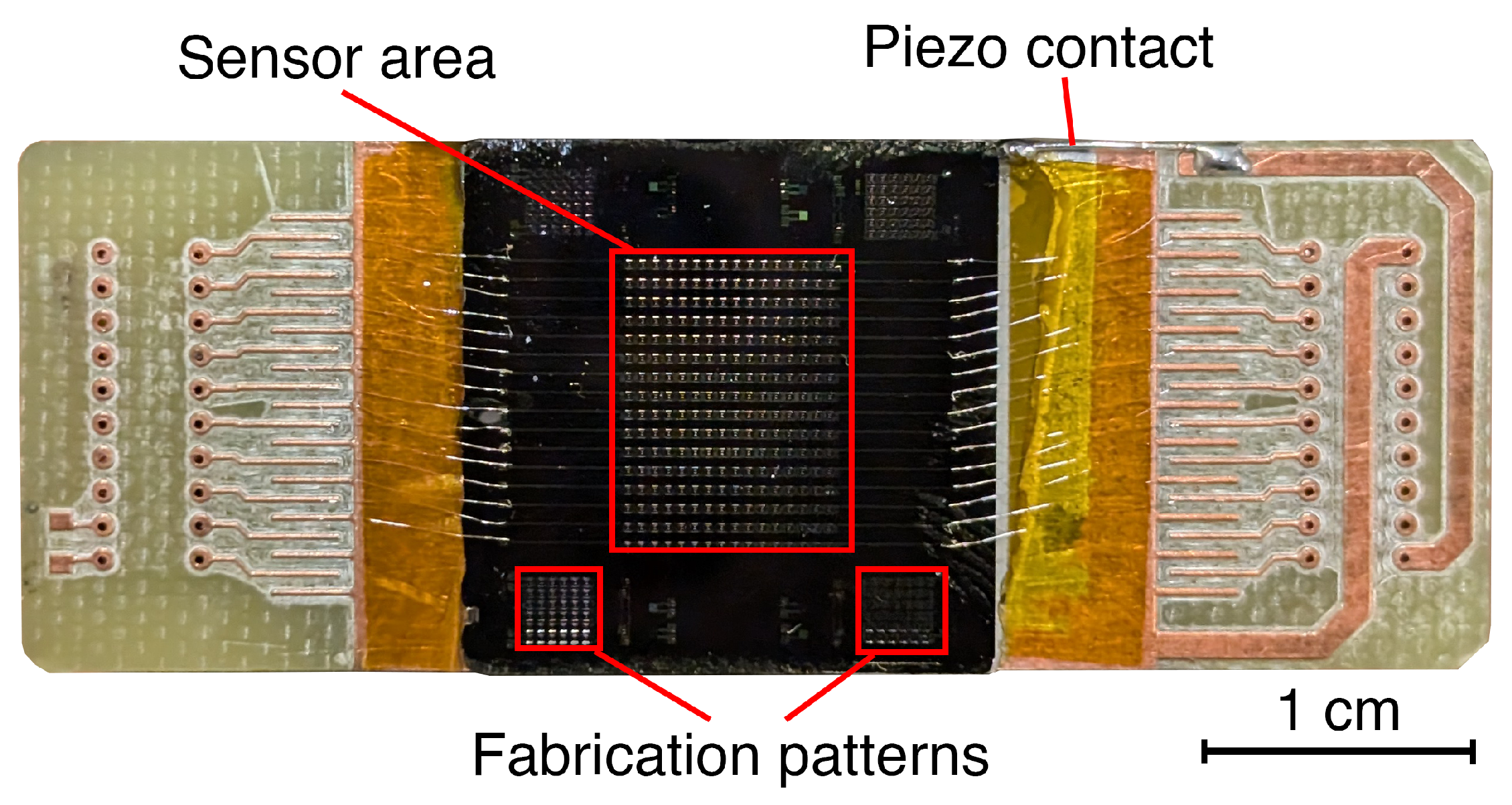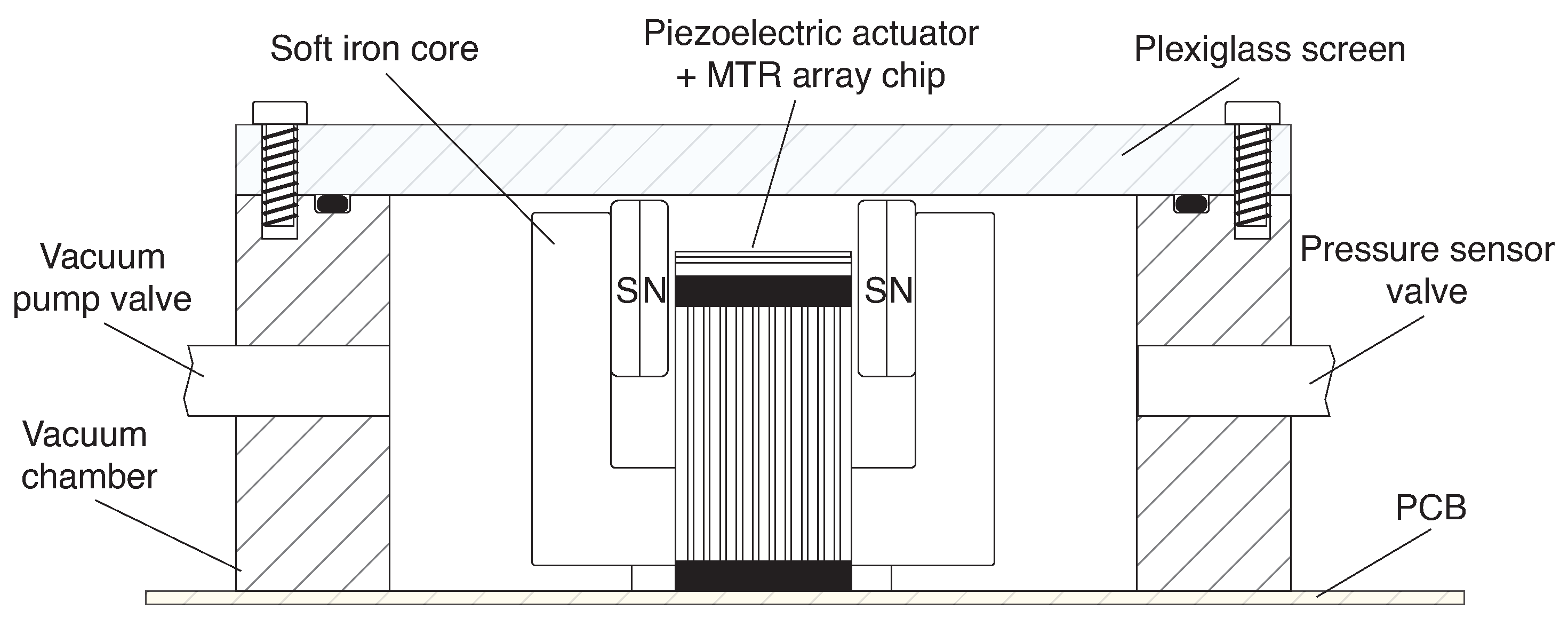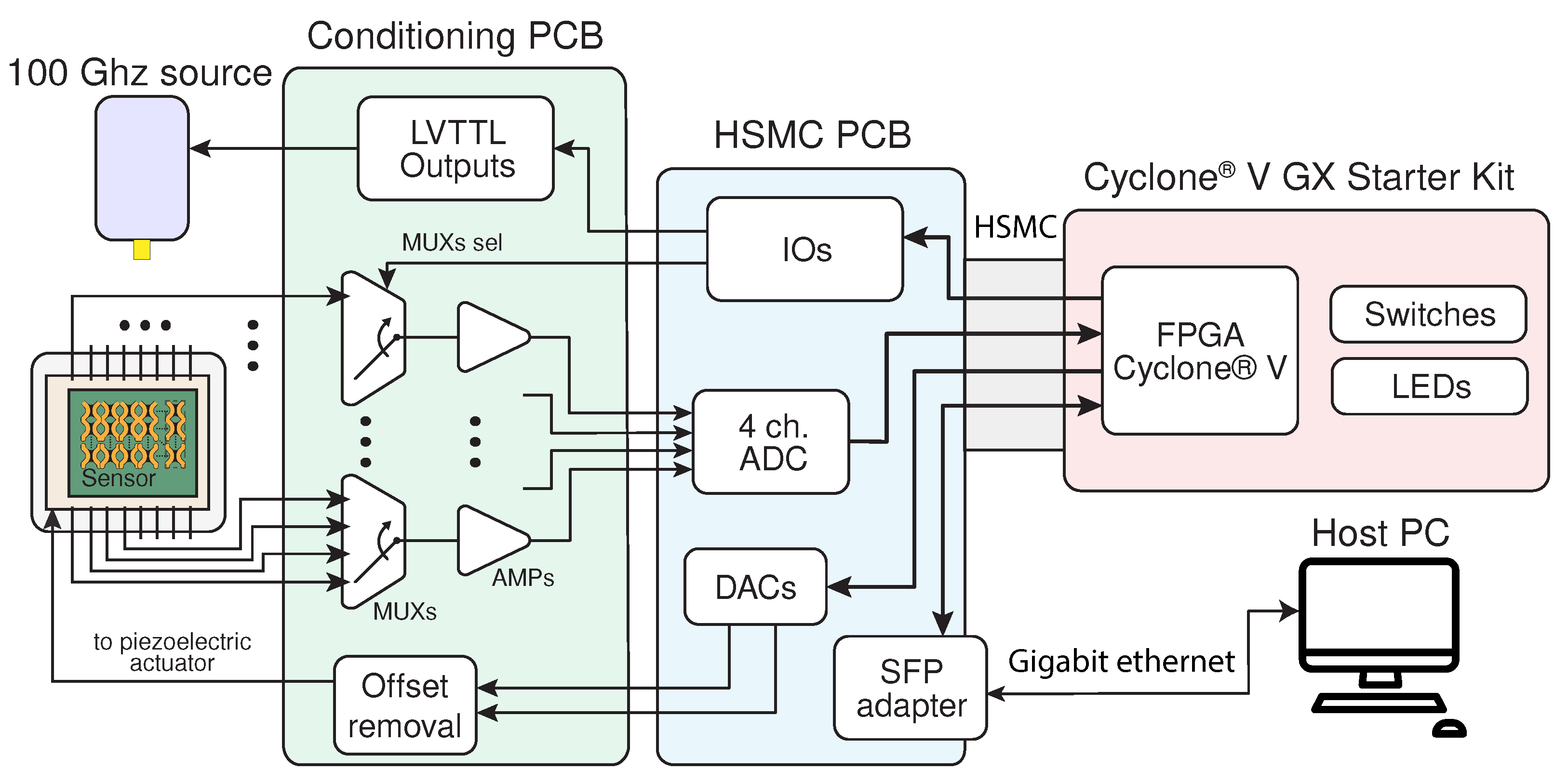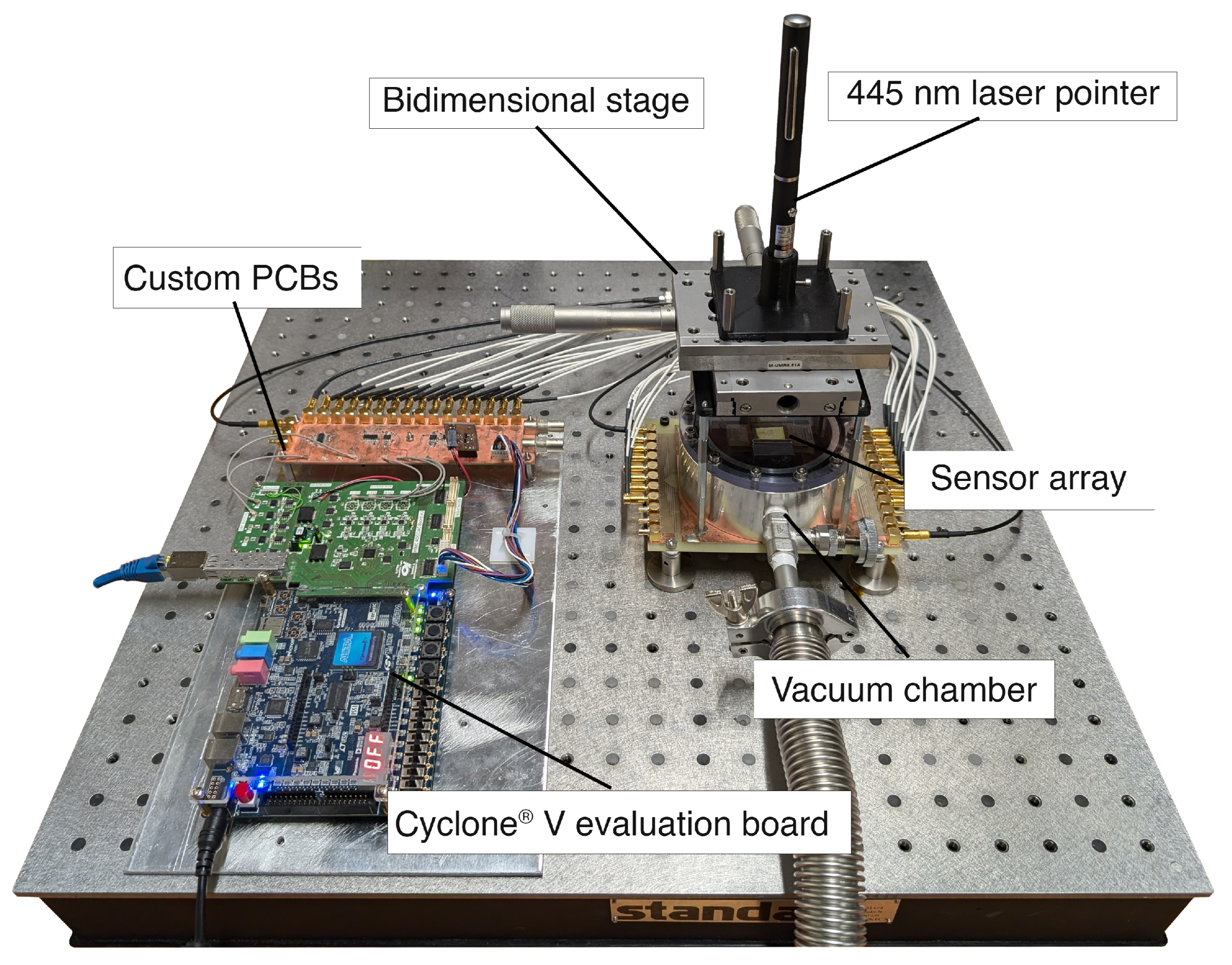FPGA Readout for Frequency-Multiplexed Array of Micromechanical Resonators for Sub-Terahertz Imaging
Abstract
:1. Introduction
2. Materials and Method
2.1. Micromechanical Trampoline Resonator
2.2. Readout Platform
- One small form-factor pluggable (SFP) connector for a gigabit communication with a host personal computer (PC);
- Four 16-bit digital-to-analog converters (DACs) with a 5V single-ended output operating at ∼1.43 MS/s (AD5541);
- One 4-channel, 16-bit analog-to-digital converter (ADC) with a ±1 V input operating at 50 MS/s (AD9553);
- Thirty-four digital input/outputs (IOs) with 2.5 V or 3.3 V levels.
- Removing the offset from the DAC signal in order to obtain 3 independent buffered outputs with a ±2.5 V range;
- Multiplexing the 16 inputs to 4 signals for the ADCs and amplifying them by a factor of 10, using 2 dual-channel analog multiplexers (DG4052E) controlled via the HSMC digital IOs;
- Providing some digital IOs in order to trigger external sources to obtain modulated experiments.
2.3. FPGA Design
2.3.1. Lock-In Design
2.3.2. Polytonal Excitation
3. Experimental Setup and Results
3.1. Laser Pointer (445 nm)
3.2. Sub-THz Source (0.1 THz)
4. Discussions and State-of-the-Art Comparison
5. Conclusions
Author Contributions
Funding
Institutional Review Board Statement
Informed Consent Statement
Data Availability Statement
Acknowledgments
Conflicts of Interest
References
- Huang, Y.; Shen, Y.; Wang, J. From Terahertz Imaging to Terahertz Wireless Communications. Engineering 2023, 22, 106–124. [Google Scholar] [CrossRef]
- Mura, M.L.; Cassioli, D.; Shundalau, M.; Cianca, E.; Lamberti, P. Graphene Devices for Aerial Wireless Communications at THz. J. Phys. Conf. Ser. 2024, 2716, 012045. [Google Scholar] [CrossRef]
- Vieira, J.; Aguirre, J.; Bradford, C.M.; Filippini, J.; Groppi, C.; Marrone, D.; Bethermin, M.; Chang, T.C.; Devlin, M.; Dore, O.; et al. The Terahertz intensity mapper (TIM): An imaging spectrometer for galaxy evolution studies at high-redshift. In Proceedings of the ISSTT 2019—30th International Symposium on Space Terahertz Technology, Proceedings Book. International Symposium on Space Terahertz Technology; Curran Associates, Inc.: New York, NY, USA, 2019; pp. 208–215. [Google Scholar]
- Cong, M.; Li, W.; Liu, Y.; Bi, J.; Wang, X.; Yang, X.; Zhang, Z.; Zhang, X.; Zhao, Y.N.; Zhao, R.; et al. Biomedical application of terahertz imaging technology: A narrative review. Quant. Imaging Med. Surg. 2023, 13, 8768. [Google Scholar] [CrossRef] [PubMed]
- Nourinovin, S.; Rahman, M.M.; Naftaly, M.; Philpott, M.P.; Abbasi, Q.H.; Alomainy, A. Highly Sensitive Terahertz Metasurface Based on Electromagnetically Induced Transparency-Like Resonance in Detection of Skin Cancer Cells. IEEE Trans. Biomed. Eng. 2024, 71, 2180–2188. [Google Scholar] [CrossRef] [PubMed]
- Kasjoo, S.R.; Mokhar, M.B.M.; Zakaria, N.F.; Juhari, N.J. A brief overview of detectors used for terahertz imaging systems. In Proceedings of the 2nd International Conference on Applied Photonics and Electronics 2019 (InCAPE 2019), Putrajaya, Malaysia, 22 August 2019; Volume 2203, p. 020020. [Google Scholar] [CrossRef]
- Bilgin, H.; Zahertar, S.; Sadeghzadeh, S.; Yalcinkaya, A.D.; Torun, H. A MEMS-based terahertz detector with metamaterial-based absorber and optical interferometric readout. Sens. Actuators A Phys. 2016, 244, 292–298. [Google Scholar] [CrossRef]
- Pitchappa, P.; Kumar, A.; Singh, R.; Lee, C.; Wang, N. Terahertz MEMS metadevices. J. Micromech. Microeng. 2021, 31, 113001. [Google Scholar] [CrossRef]
- Lulec, S.Z.; Sagiroglu, C.; Mostafazadeh, A.; Ermek, E.; Timurdogan, E.; Leblebici, Y.; Urey, H. Simultaneous self-sustained actuation and parallel readout with MEMS cantilever sensor array. In Proceedings of the 2012 IEEE 25th International Conference on Micro Electro Mechanical Systems (MEMS), Paris, France, 29 January–2 February 2012; pp. 644–647. [Google Scholar] [CrossRef]
- Ma, J.; Karl, N.J.; Bretin, S.; Ducournau, G.; Mittleman, D.M. Frequency-division multiplexer and demultiplexer for terahertz wireless links. Nat. Commun. 2017, 8, 729. [Google Scholar] [CrossRef] [PubMed]
- Wang, M.; Zhang, Y.; Li, G.P.; Bachman, M. Frequency Multiplexed MEMS Actuators and Switches. IEEE Electron Device Lett. 2013, 34, 132–134. [Google Scholar] [CrossRef]
- Vicarelli, L.; Tredicucci, A.; Pitanti, A. Micromechanical bolometers for subterahertz detection at room temperature. ACS Photonics 2022, 9, 360–367. [Google Scholar] [CrossRef] [PubMed]
- Schmid, S.; Villanueva, L.G.; Roukes, M.L. Fundamentals of Nanomechanical Resonators; Springer International Publishing: Heidelberg, Germany, 2023. [Google Scholar] [CrossRef]
- Zhang, Y.; Hosono, S.; Nagai, N.; Hirakawa, K. Effect of Buckling on the Thermal Response of Microelectromechanical Beam Resonators. Appl. Phys. Lett. 2017, 111, 023504. [Google Scholar] [CrossRef]
- Gregorat, L.; Cautero, M.; Vicarelli, L.; Giuressi, D.; Bagolini, A.; Tredicucci, A.; Cautero, G.; Pitanti, A. Highly dispersive multiplexed micromechanical device array for spatially resolved sensing and actuation. Microsyst. Nanoeng. 2024; in press. [Google Scholar]
- Xu, X.; Chen, Z.; Li, H.; Ma, S.; Wu, L.; Wang, W.; Dong, Y.; Zhan, W. Design of A High-Precision Component-Type Vertical Pendulum Tiltmeter Based on FPGA. Sensors 2023, 23, 7998. [Google Scholar] [CrossRef] [PubMed]
- Garzetti, F.; Salgaro, S.; Venialgo, E.; Lusardi, N.; Corna, N.; Geraci, A.; Charbon, E. Plug-and-play TOF-PET Module Readout Based on TDC-on-FPGA and Gigabit Optical Fiber Network. In Proceedings of the 2019 IEEE Nuclear Science Symposium and Medical Imaging Conference (NSS/MIC), Manchester, UK, 9 April 2020; pp. 1–4. [Google Scholar] [CrossRef]
- Sonnaillon, M.O.; Bonetto, F.J. A low-cost, high-performance, digital signal processor-based lock-in amplifier capable of measuring multiple frequency sweeps simultaneously. Rev. Sci. Instrum. 2005, 76, 024703. [Google Scholar] [CrossRef]
- Baldacci, L.; Pitanti, A.; Masini, L.; Arcangeli, A.; Colangelo, F.; Navarro-Urrios, D.; Tredicucci, A. Thermal noise and optomechanical features in the emission of a membrane-coupled compound cavity laser diode. Sci. Rep. 2016, 6, 31489. [Google Scholar] [CrossRef]
- Borovic, B.; Liu, A.Q.; Popa, D.; Cai, H.; Lewis, F.L. Open-loop versus closed-loop control of MEMS devices: Choices and issues. J. Micromech. Microeng. 2005, 15, 1917. [Google Scholar] [CrossRef]
- Mura, M.L.; Lamberti, P.; Tucci, V.; Jorudas, J.; Cojocari, M.; Fedorov, G.; Kuzhir, P. Exploring the Impact of Absorber Material on the Performance of a Terahertz Microbolometer by Finite Element Analysis. In Proceedings of the 2023 IEEE Nanotechnology Materials and Devices Conference (NMDC), Paestum, Italy, 22–25 October 2023; pp. 520–524. [Google Scholar] [CrossRef]
- Sage, E.; Sansa, M.; Fostner, S.; Defoort, M.; Gély, M.; Naik, A.K.; Morel, R.; Duraffourg, L.; Roukes, M.L.; Alava, T.; et al. Single-Particle Mass Spectrometry with Arrays of Frequency-Addressed Nanomechanical Resonators. Nat. Commun. 2018, 9, 3283. [Google Scholar] [CrossRef] [PubMed]
- Lamberti, F.R.; Palanchoke, U.; Geurts, T.P.J.; Gely, M.; Regord, S.; Banniard, L.; Sansa, M.; Favero, I.; Jourdan, G.; Hentz, S. Real-Time Sensing with Multiplexed Optomechanical Resonators. Nano Lett. 2022, 22, 1866–1873. [Google Scholar] [CrossRef] [PubMed]
- Burdett, R. Amplitude Modulated Signals: The Lock-in Amplifier. In Handbook of Measuring System Design; John Wiley & Sons, Ltd.: Hoboken, NJ, USA, 2005; Chapter 181. [Google Scholar] [CrossRef]
- Milic, L.; Saramaki, T.; Bregovic, R. Multirate Filters: An Overview. In Proceedings of the APCCAS 2006—2006 IEEE Asia Pacific Conference on Circuits and Systems, Singapore, 4–7 December 2006; pp. 912–915. [Google Scholar] [CrossRef]
- Winser, A.; Cranos, W. Chapter 5—Implementation of Discrete Time Systems. In Digital Signal Processing; Winser, A., Cranos, W., Eds.; Academic Press: Boston, MA, USA, 2017; pp. 277–350. [Google Scholar] [CrossRef]
- Vaithiyanathan, D.; James, B.P.; Mariammal, K. Comparative Study of Single MAC FIR Filter Architectures with Different Multiplication Techniques. In Proceedings of the 2023 Second International Conference on Electrical, Electronics, Information and Communication Technologies (ICEEICT), Trichirappalli, India, 5–7 April 2023; pp. 1–10. [Google Scholar] [CrossRef]
- Chen, W.; Huang, M.; Lou, X. Design of Sparse FIR Filters With Reduced Effective Length. IEEE Trans. Circuits Syst. I Regul. Pap. 2019, 66, 1496–1506. [Google Scholar] [CrossRef]
- Garcia, R.; Volkova, A.; Kumm, M.; Goldsztejn, A.; Kühle, J. Hardware-Aware Design of Multiplierless Second-Order IIR Filters With Minimum Adders. IEEE Trans. Signal Process. 2022, 70, 1673–1686. [Google Scholar] [CrossRef]
- Meyer-Baese, U. Digital Signal Processing with Field Programmable Gate Arrays, 4th ed.; Springer: Berlin, Heidelberg, 2014. [Google Scholar]
- Mitra, S.K.K. Digital Signal Processing: A Computer-Based Approach, 2nd ed.; McGraw-Hill Higher Education: Columbus, OH, USA, 2000. [Google Scholar]
- Parhi, K.K. VLSI Digital Signal Processing Systems: Design and Implementation, 1st ed.; John Wiley & Sons, Ltd.: Hoboken, NJ, USA, 1999. [Google Scholar]
- Altera Corporation. Cyclone® V Device Handbook, Volume 1: Device Interfaces and Integration, cv-5v2 ed.; Altera Corporation: San Jose, CA, USA, 2023. [Google Scholar]
- Jorudas, J.; Rehman, H.; Cojocari, M.; Pashnev, D.; Urbanowicz, A.; Kašalynas, I.; Bertoni, B.; Vicarelli, L.; Pitanti, A.; Malykhin, S.; et al. Ultra-broadband absorbance of nanometer-thin pyrolyzed-carbon film on silicon nitride membrane. Nanotechnology 2024, 35, 305705. [Google Scholar] [CrossRef] [PubMed]















| Logic Utilization | BRAM | DSP | |
|---|---|---|---|
| [ALMs] | [M10K] | ||
| Design | 17,012/29,080 | 137/446 | 101/150 |
| Lock-in matrix | 9193/29,080 | 3/446 | 96/150 |
| Lock-in amplifier | 145/29,080 | 0/446 | 3/150 |
| 2-Slow IIR filter | 27/29,080 | 0/446 | 1/ 150 |
| Network wrapper | 3168/29,080 | 62/446 | 0/ 150 |
Disclaimer/Publisher’s Note: The statements, opinions and data contained in all publications are solely those of the individual author(s) and contributor(s) and not of MDPI and/or the editor(s). MDPI and/or the editor(s) disclaim responsibility for any injury to people or property resulting from any ideas, methods, instructions or products referred to in the content. |
© 2024 by the authors. Licensee MDPI, Basel, Switzerland. This article is an open access article distributed under the terms and conditions of the Creative Commons Attribution (CC BY) license (https://creativecommons.org/licenses/by/4.0/).
Share and Cite
Gregorat, L.; Cautero, M.; Pitanti, A.; Vicarelli, L.; La Mura, M.; Bagolini, A.; Sergo, R.; Carrato, S.; Cautero, G. FPGA Readout for Frequency-Multiplexed Array of Micromechanical Resonators for Sub-Terahertz Imaging. Sensors 2024, 24, 7276. https://doi.org/10.3390/s24227276
Gregorat L, Cautero M, Pitanti A, Vicarelli L, La Mura M, Bagolini A, Sergo R, Carrato S, Cautero G. FPGA Readout for Frequency-Multiplexed Array of Micromechanical Resonators for Sub-Terahertz Imaging. Sensors. 2024; 24(22):7276. https://doi.org/10.3390/s24227276
Chicago/Turabian StyleGregorat, Leonardo, Marco Cautero, Alessandro Pitanti, Leonardo Vicarelli, Monica La Mura, Alvise Bagolini, Rudi Sergo, Sergio Carrato, and Giuseppe Cautero. 2024. "FPGA Readout for Frequency-Multiplexed Array of Micromechanical Resonators for Sub-Terahertz Imaging" Sensors 24, no. 22: 7276. https://doi.org/10.3390/s24227276
APA StyleGregorat, L., Cautero, M., Pitanti, A., Vicarelli, L., La Mura, M., Bagolini, A., Sergo, R., Carrato, S., & Cautero, G. (2024). FPGA Readout for Frequency-Multiplexed Array of Micromechanical Resonators for Sub-Terahertz Imaging. Sensors, 24(22), 7276. https://doi.org/10.3390/s24227276







